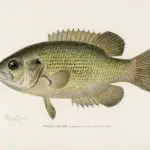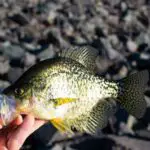After spawning, female crappies generally head back to deeper water and scatter, making them more difficult to find. The best place to look for them is near deep woody covers, such as sunken trees or brush piles. You may also want to look for any rises, drops, ledges, stumps, rock piles or anything different on the bottom contour.
1. Where do crappies go after they spawn?
After spawning, crappies generally head back to deeper water and frequently scatter, making them more difficult to find. Look for them near deep woody cover, such as sunken trees or brush piles. Look for any rises, drops, ledges, stumps, rock piles or anything different on the bottom contour.
2. What is the journey like for a crappie?
A crappie is a freshwater fish that is popular among anglers. They are relatively easy to catch and can be found in many lakes and rivers across North America. Crappies are not very large, typically only reaching around 10-12 inches in length. However, they can provide a good fight when hooked and are excellent table fare.
So what is the journey like for a crappie? Well, it starts out much like any other fish. The female will lay her eggs in shallow water near some sort of cover (rocks, logs, etc.). Once the eggs hatch, the young fry will spend their time hiding amongst the cover from predators. As they grow larger, they will start to venture out into open water more and more. By late summer/early fall, most crappies will be fully grown adults weighing around 1 pound or so.
During the winter months, crappies will often congregate in deep water near structure where they can find refuge from cold temperatures and predators. In springtime, as waters start to warm up again, they will move back into shallower areas to feed on spawning baitfish and insects.
3. How long does it take for a crappie to Spawn?
The crappie spawn occurs every spring when the water temperatures reach above 60 degrees. Depending on where you live, the crappie spawn can be anytime from early March to the middle of May.
Like other panfish, crappie build spawning nests in shallow water generally ranging between 1-6 feet of water. The female fish lay their eggs in the nest and then both parents guard the eggs until they hatch. It takes about 10-12 days for the eggs to hatch and for the fry (baby fish) to become free swimming.
Once the fry are free swimming, they will stay close to their parents for protection from predators. After a few weeks, the fry will begin to disperse and start feeding on their own. Crappies typically reach maturity at 2-3 years old and can live up to 8 years in ideal conditions.
4. What are the conditions that must be met for a successful Spawning event?
A successful Spawning event requires the following conditions to be met:
1. The correct environmental cues must be present. These cues include things like water temperature, day length, and the presence of certain chemicals in the water. 2. The fish must be healthy and have a good body condition. If they are too skinny or sick, they will not spawn. 3. There must be enough food available for the fry (baby fish) to eat once they hatch. Otherwise, they will not survive long enough to grow into adults. 4. There must be suitable places for the eggs to be laid and for the fry to hide from predators while they are growing up. 5.
5. Are there different types of spawning habitats preferred by crappies ?
There are definitely different types of spawning habitats preferred by crappies. In areas with murky water and thick cover, they are often found close to the bank. However, in clearer waters they tend to prefer areas that are a bit deeper, around 2-4 feet deep. They also like places with plenty of cover, such as brush, flooded timber or weeds. This provides them with protection from predators and gives them easy access to deeper water if necessary.
6. Is water temperature critical during the spawn ?
Spawning is a crucial life stage for many fish species, and water temperature can play a critical role in determining whether or not spawning is successful. In general, warmer water temperatures are more conducive to successful spawning, as they help speed up the development of eggs and larvae. However, there can be too much of a good thing – if water temperatures get too high, it can lead to developmental problems and ultimately lower survival rates. For this reason, it’s important to maintain moderate water temperatures during the spawn in order to give your fish the best chance of success.
7. What other environmental factors playa role in where and when spawning occurs ?
There are a number of different environmental factors that can influence where and when fish spawn. One of the most important factors is water temperature. Most fish species prefer to spawn in waters that are between 60 and 80 degrees Fahrenheit. Another factor that can influence spawning is the amount of dissolved oxygen present in the water.
Fish need oxygen to survive, so they are more likely to spawned in areas where there is a higher concentration of dissolved oxygen. Additionally, many fish species prefer to spawn near sources of food, such as plants or other small aquatic creatures. This ensures that their offspring will have plenty to eat once they hatch.
Finally, some fish species only spawn during certain times of year when conditions are just right. For example, salmon typically only spawning during the late summer or early fall months when water temperatures are cooler but not too cold.
8. What impact does human activity have on spawning locations and success rates ?
Humans have a significant impact on the spawning locations and success rates of fish. We can change the location of where fish spawn by damming rivers and altering the flow of water. This can reduce the amount of oxygen in the water, which can be detrimental to fish eggs. Additionally, we can pollute waterways with chemicals and trash, which can also negatively affect fish spawning success.
9. How can anglers locate post-spawn crappies ?
After a long winter of waiting, crappie spawn season is finally here! But once the spawn is over, where do these fish go? And how can anglers locate them? Here are a few tips on finding post-spawn crappies.
One of the best ways to find post-spawn crappies is to look for areas with cover. This could be anything from submerged brush piles to docks and piers. Crappies like to spend time around cover because it provides them with a place to hide from predators and ambush their prey. So if you’re looking for post-spawn fish, focus your efforts on areas with plenty of cover.
Another good way to locate post-spawn crappies is by paying attention to the water temperature. After spawning, crappies will often move into deeper water where the water temperature is cooler and more comfortable for them. So if you’re having trouble finding fish in shallower waters, try moving out into deeper waters where the temperature may be more conducive for holding fish.
Finally, one last tip for finding post-spawn crappies is simply spending time on the water and getting to know your lake or river well. The more time you spend fishing an area, the better you’ll get at understanding patterns and figuring out where fish are likely to be at different times of year. With enough time and effort spent scouting an area, you should eventually be ableto narrow down some productive spots for targeting post-spawn fish.



